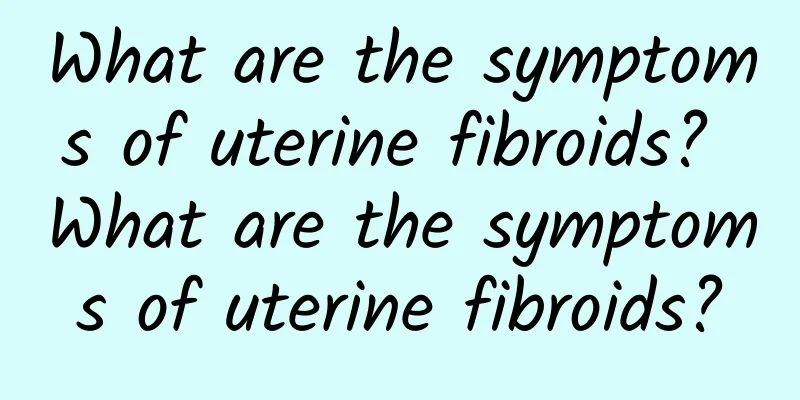What are the symptoms of uterine fibroids? What are the symptoms of uterine fibroids?

|
Most patients with uterine fibroids do not have obvious symptoms. If symptoms occur, they are closely related to the location, growth rate and degeneration of the fibroids. The most common symptom is menstrual changes, which are manifested as shortened cycles, increased menstrual volume, prolonged menstruation, irregular vaginal bleeding, etc. Other manifestations include increased leucorrhea, frequent urination, difficulty urinating, difficulty defecating, backache, lower abdominal swelling, etc. 1. Symptoms of uterine fibroids can manifest as menstrual changes. When tumors grow in the uterus, such as uterine fibroids, endometrial cancer, uterine sarcoma, and choriocarcinoma, menstrual abnormalities may occur, including menorrhagia, irregular cycles, prolonged menstruation, spotting, etc. Some ovarian tumors, such as granulosa cell tumors and theca cell tumors, can secrete estrogen, interfere with the menstrual cycle, and cause menstrual abnormalities. 2. Uterine bleeding is the most common symptom of uterine fibroids. The clinical manifestations are menorrhagia, cyclical bleeding, increased menstrual volume, and often accompanied by prolonged menstruation. This type of bleeding is the most common; frequent menstruation, shortened menstrual cycle, increased menstrual volume; irregular bleeding, loss of normal menstrual periodicity, prolonged duration, and prolonged bleeding are more common in submucosal fibroids. 3. The uterus is located deep in the pelvic cavity. When the fibroids begin, the mass cannot be touched in the abdomen. When the uterine fibroids gradually increase in size, the uterine pregnancy size exceeds 3 months, or the subserosal fibroids located at the bottom of the uterus are easier to touch from the abdomen. The mass is located in the middle of the lower abdomen, practical and movable, but not very active, no tenderness, and grows slowly. If the patient's abdominal wall is thick, the uterus is enlarged, or exceeds the pelvic cavity, even up to 4~5 months, it is still difficult for the patient to find it by himself. The above is an introduction to the symptoms of uterine fibroids. If you feel that your symptoms are similar, experts recommend that you go to the hospital for examination as soon as possible to avoid delaying the treatment of the disease. |
<<: Is the mass in the abdomen a uterine fibroid? What are the dangers of uterine fibroids?
>>: How to diagnose uterine fibroids? Can uterine fibroids cause uterine bleeding?
Recommend
Six months after marriage, men are prone to obesity, women are prone to obesity
Marriage is the beginning of obesity, what to do?...
Treatment of menopausal functional uterine bleeding based on TCM classification
Menopausal functional uterine bleeding is general...
What is cervical erosion
Cervical erosion is a common disease among women,...
The specific symptoms of uterine fibroids need to be carefully analyzed
Since the symptoms of uterine fibroids are not ve...
How to induce menstruation when the endometrium is 7mm
When the endometrium is 7mm, you can consider tak...
1 minute of acupressure every day! Press out the charming clavicle line
You must have heard of "collarbone beauty&qu...
Is the pain an injury or fatigue? Cumulative injuries
I don't know when it started, but the term &q...
Why can't you have sex after an abortion? How many abortions will it take to stop having children?
Why can't you have sex after having an aborti...
It turns out that eating vegetables first and then meat to lose weight is wrong! Famous weight loss doctor: Eating dietary fiber first can increase appetite
There are many diet instructions on the Internet ...
Brief analysis of physical therapy for severe cervical erosion
Physical therapy is a common method for treating ...
What is chronic pelvic inflammatory disease? What should we do?
What is chronic pelvic inflammatory disease? What...
What can I eat to make my uterine fibroids smaller? What can I eat to make my uterine fibroids disappear?
Uterine fibroids are a common gynecological disea...
Is it good to drink saffron for chocolate cysts?
For patients with chocolate cysts, if they experi...
Could Too Much Sugar Cause Cancer? Which one is more nutritious, white sugar or brown sugar? Zhao Hanying teaches you how to eat candy wisely
Sweets are a woman’s second stomach, such as ice ...
What should be considered when considering the cost of painless abortion surgery?
As many women begin to use painless abortion to r...









